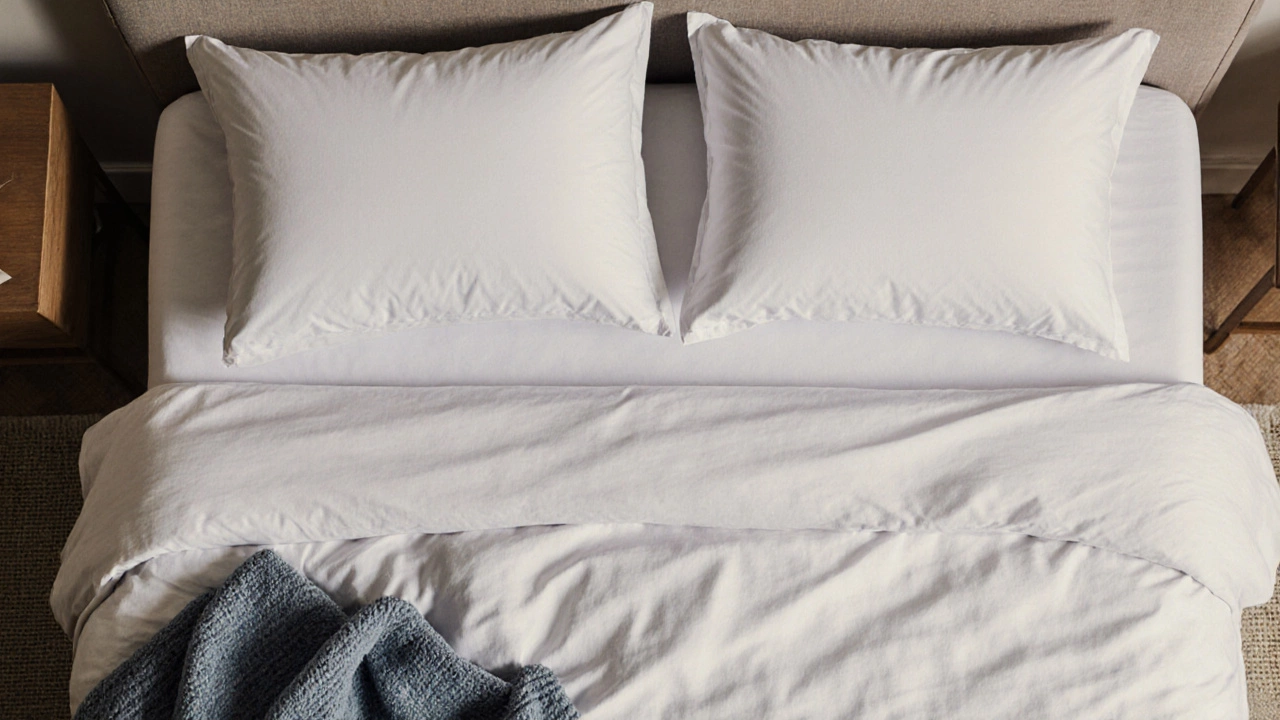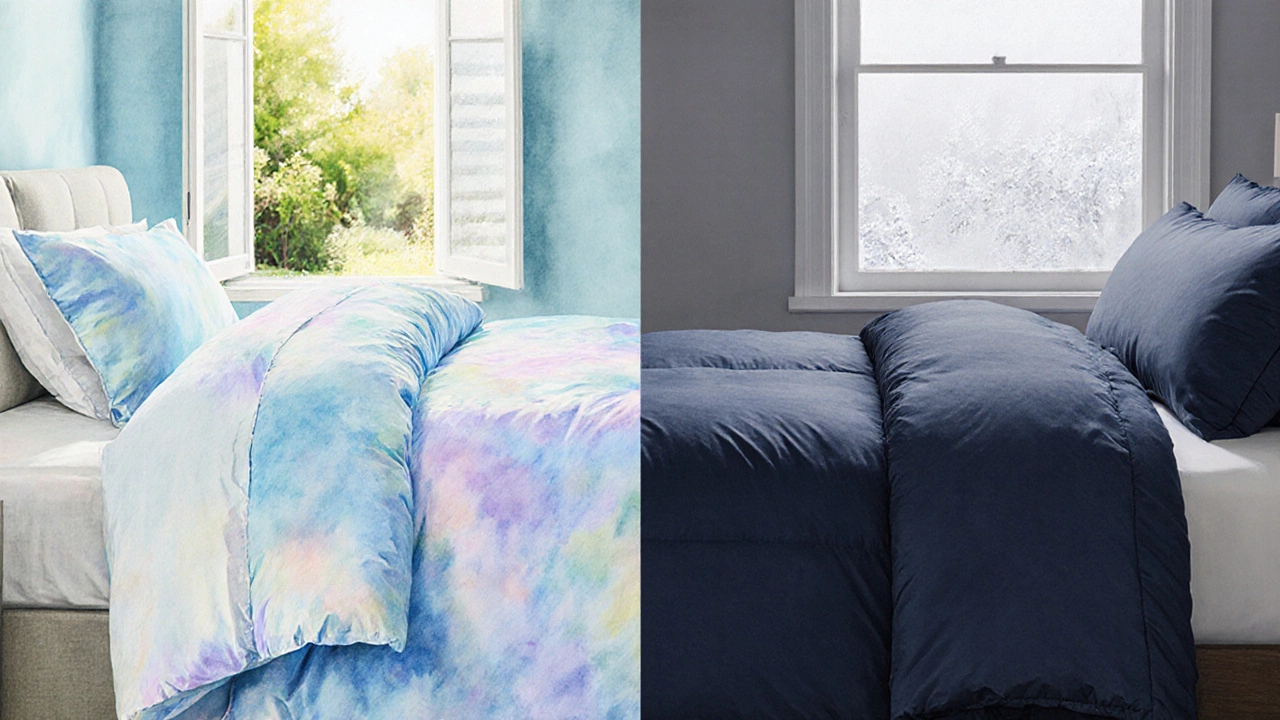Ever stood in a bedroom aisle wondering whether you need a sheet set or a duvet? You’re not alone-most shoppers get stuck on this choice because the terminology can feel confusing. In this guide we’ll break down the two core bedding types, explain how each works, and give you a clear roadmap for picking the right one for your sleep style, climate, and décor.
What Exactly Is Bedding?
Bedding is a collection of textile items that cover a mattress and provide comfort, warmth, and aesthetic appeal. It includes everything from the fitted sheet that hugs the mattress to the decorative shams that finish a layered look. While there are many accessories-pillows, blankets, mattress protectors-the core functional pieces fall into two families: sheet sets and duvet systems.
The Two Core Families of Bedding
All modern bedding can be grouped under either a Sheet Set - a coordinated kit of flat, fitted, and pillowcase pieces. or a Duvet - a removable, insulated insert paired with a protective cover. Each family solves the same problem-keeping you warm and comfortable-but does so in a different way.
Sheet Set: The Classic, All‑In‑One Solution
A sheet set typically includes three essential components:
- Fitted sheet: elasticized corners that hug the mattress, preventing bunching.
- Flat sheet: a lightweight layer between you and the blanket or comforter.
- Pillowcases: sleeves that protect pillows and add a polished look.
Why many people stick with sheet sets:
- Simple layering. You can add or remove a top blanket without disturbing the base layers.
- Seasonal flexibility. Swap a lightweight cotton flat sheet in summer for a flannel blanket in winter.
- Cost‑effectiveness. A complete set usually costs less per night of use than a duvet system.
Materials range from breathable cotton and linen to cozy flannel, jersey, or even bamboo blends. Thread count matters-values between 200‑400 are ideal for everyday comfort, while luxury picks push past 600.

Duvet System: The Modern, Swap‑And‑Go Approach
A duvet system consists of two parts: the duvet insert, filled with down, feather, synthetic fibers, or a hybrid blend, and a duvet cover, which functions like a giant pillowcase.
Key advantages of duvets:
- Easy cleaning. You wash the cover weekly; the insert only needs occasional airing or spot‑cleaning.
- All‑season warmth. A lightweight summer duvet pairs with a heavier winter insert, all without changing the visible cover.
- Design versatility. Changing the cover instantly refreshes the bedroom’s look-no stitching or sewing required.
Fill power is the industry’s measure of loft and insulation. A fill power of 600‑700 offers a balanced warmth‑to‑weight ratio, while 800+ is ultra‑light for colder climates.
Choosing Between a Sheet Set and a Duvet
Consider these four decision criteria before you buy:
- Climate: Hot sleepers in humid regions often prefer a sheet set with a lightweight blanket, while colder climates benefit from the insulated duvet.
- Lifestyle: Frequent travelers love the portability of a duvet cover that fits into a suitcase; families with kids may favor the durability of a sheet set that can be swapped quickly after spills.
- Maintenance: If you dislike laundering bulky comforters, a duvet system’s removable cover is a win. Sheet sets require washing all pieces, but the fabrics are usually lighter and dry faster.
- Design goals: Want a quick way to change colours? Duvet covers make that effortless. Want a layered look with visible textures? A sheet set with a decorative blanket offers depth.
Below is a quick side‑by‑side comparison to visualise the trade‑offs.
| Feature | Sheet Set | Duvet System |
|---|---|---|
| Core components | Fitted sheet, flat sheet, pillowcases | Duvet insert + removable cover |
| Seasonal swap | Replace blanket or add layers | Swap insert or change cover |
| Cleaning routine | Wash all pieces weekly | Wash cover weekly; insert rarely |
| Cost per night | Usually lower upfront | Higher initial cost, longer lifespan |
| Design flexibility | Layered textures, colours | Cover changes colour instantly |

Care & Maintenance Tips
Both families need proper care to stay fresh and last years:
- Sheet sets: Wash in warm water (30‑40°C) with gentle detergent. Avoid fabric softeners on cotton to preserve breathability. Tumble dry low or line‑dry to prevent shrinkage.
- Duvet covers: Remove weekly, wash inside‑out on a gentle cycle. Use a large‑capacity dryer with dryer balls to keep the fabric fluffy.
- Duvet inserts: Air out monthly in sunlight to deter mites. If down, consider a professional clean every 12‑18 months; synthetic fills can be spot‑cleaned.
- Pillowcases: Replace or wash every 3‑4 days for hygiene, especially for skin‑sensitive sleepers.
Store off‑season bedding in breathable cotton bags, not plastic, to avoid moisture buildup.
Quick Decision Checklist
- Do you live in a climate with distinct seasonal temperature swings? Choose duvet.
- Is easy washing a top priority? Sheet set.
- Do you enjoy frequently updating bedroom colour schemes? Duvet cover.
- Do you have pets or kids prone to messes? Durable sheet set with a washable blanket.
Frequently Asked Questions
Can I mix a sheet set with a duvet?
Absolutely. Most people use a fitted sheet, a flat sheet, and a duvet cover together. The flat sheet provides an extra breathable layer beneath the duvet.
Which is more hypoallergenic: sheet sets or duvets?
Both can be hypoallergenic if you choose the right materials. Look for organic cotton sheets and down‑alternative fills with anti‑mite treatments for the duvet.
How often should I replace my bedding?
High‑quality cotton sheets last about 5‑7 years with proper care. Duvet inserts can last 10‑15 years, while covers should be replaced every 2‑3 years for colour freshness.
Is a duvet cover necessary for warmth?
The cover itself adds a thin layer of insulation, but the primary warmth comes from the duvet fill. A cover also protects the fill from dirt and sweat, extending its lifespan.
What thread count should I look for in a sheet set?
For most sleepers, 200‑400 provides a good balance of softness and durability. Higher counts feel silkier but can be less breathable.

